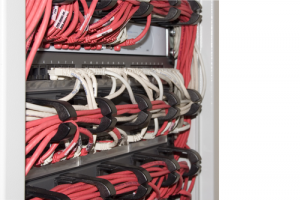As smart home technology continues to evolve, plenty of early adopters have already jumped on board. Others are waiting for prices to drop and the capabilities to become more mainstream. No matter which wagon you’re on, you should start with the proper electrical wiring and Cat5 cabling to power smart devices whenever and wherever you want to add them.
Wi-Fi can do it a lot, but it’s not the most reliable form of device networking. Portable devices (your phone, tablet, and laptop) will always be wireless, but stationary smart home appliances (the refrigerator, overhead lights, air conditioner, etc.) can benefit from hardwired Ethernet via Cat5 cabling.
Ethernet is not the only thing you need for smart home networking. Many devices—specifically, the home lighting systems—use powerline communication over your electrical wiring. Your home might need some electrical upgrades for this to work, however.
A licensed electrician can install Cat5 cabling throughout your home (or office) as well as ensuring you have proper electrical wiring where you need it.
Cat5 Cabling for Smart Homes
 For home networking, Cat5 cabling is the standard bearer. You could pay a little more for the materials and get Cat6 or Cat7 cabling for faster speeds, less crosstalk, and better performance.
For home networking, Cat5 cabling is the standard bearer. You could pay a little more for the materials and get Cat6 or Cat7 cabling for faster speeds, less crosstalk, and better performance.
Let’s run down a few examples of why smart homes should use cabling for hardwired rather than wireless connections.
- Faster speeds: Wired networks can operate at the maximum speed of the cabling you use. That’s 100 Mbps for Cat5 cabling and 10 Gbps for Cat6 or Cat7 cabling. You might have 100 Mbps internet service, but you can’t expect that speed for dozens of different devices all at once on Wi-Fi. Many smart home features on cabling can communicate with each other at the full 100 Mbps or higher, regardless of your actual internet speed.
- Better reliability: You want your smart home security, lighting, and HVAC systems to work when you need them to. How often do you need to reboot your router or reconnect to your Wi-Fi network? For important home functions, wireless problems are too common.
- Smoother connections: Besides fewer dropped connections, you can expect better performance on networks with Cat5 cabling. There’s less interference and less latency, which improves streaming video, sound systems, online gaming, home security videos, and more.
- Better Wi-Fi: Finally, you probably need cable jacks in more than one place to get strong wireless internet everywhere in the building. Add Cat5 cabling for better results than using expensive signal boosters that may or may not work.
Powerline Networking
Some smart home capabilities use powerline commands rather than either cabling or wireless. This means that signals get sent over the regular electrical wiring. For example, many smart light switches and ceiling fans use powerline networking.
The problem is that many wall switches don’t have a neutral wire, because they’re not necessary. You won’t be able to enjoy the smart commands like telling your home to turn off all the lights or switch to a pre-programmed dimmed lights for movie viewing or romantic dining if you don’t have neutral wires at all the light switches.
While getting your Cat5 cabling for the home network, an electrician can also run neutral wires and make any other electrical repairs and upgrades necessary to power your smart home system.
Setting up a smart home with Cat5 cabling? Contact us to request a free estimate or home network wiring and other upgrades by a licensed, local electrician.

